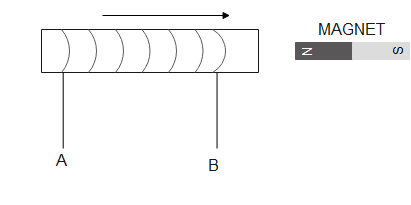
In what direction does the induced current in coil flow?

A) A to B
B) B to A
C) No current flow
D) Can't say

Answer
554.4k+ views
Hint: we can judge according to Faraday's law of electromagnetic induction, and this process will be according to Lenz's law. By knowing the magnetic polarity of the coil side we can easily determine the direction of the induced current with the help of applying the right-hand rule.
Complete answer:
We know that, If we keep the magnet stationary and move the coil back and forth within the magnetic field an electric current would be induced in the coil. Then by either moving the wire or changing the magnetic field we can induce a voltage and current within the coil is possible and this process is known as Electromagnetic Induction (EI). This means when the coil AB is approaching towards the north pole of the magnet, the magnetic flux linking to the coil increases. In order to Faraday's law of electromagnetic induction, when there is a change in flux an emf and hence current is induced in the coil and this current will create its own magnetic field.
Now according to Lenz's law, which states that the direction of the current induced in a conductor by a changing magnetic field. Here this magnetic field created will oppose its own or we can say opposes the decrease in flux through the coil and this is possible only if approaching coil side attains south polarity, as we know very well dissimilar poles attract each other. Once we know the magnetic polarity of the coil side then we can easily determine the direction of the induced current by applying the right-hand rule. So, in this case, the current flows in the A to B direction.
Hence, the correct answer is option A.
Note:
In this case, they keep the bar magnet stationary and coil move the north pole of the magnet. Similarly, if the coil keeps stationery and the bar magnet in motion the same result will occur. If you know his basic thing we can determine the final answer by just applying the right-hand rule.
Complete answer:
We know that, If we keep the magnet stationary and move the coil back and forth within the magnetic field an electric current would be induced in the coil. Then by either moving the wire or changing the magnetic field we can induce a voltage and current within the coil is possible and this process is known as Electromagnetic Induction (EI). This means when the coil AB is approaching towards the north pole of the magnet, the magnetic flux linking to the coil increases. In order to Faraday's law of electromagnetic induction, when there is a change in flux an emf and hence current is induced in the coil and this current will create its own magnetic field.
Now according to Lenz's law, which states that the direction of the current induced in a conductor by a changing magnetic field. Here this magnetic field created will oppose its own or we can say opposes the decrease in flux through the coil and this is possible only if approaching coil side attains south polarity, as we know very well dissimilar poles attract each other. Once we know the magnetic polarity of the coil side then we can easily determine the direction of the induced current by applying the right-hand rule. So, in this case, the current flows in the A to B direction.
Hence, the correct answer is option A.
Note:
In this case, they keep the bar magnet stationary and coil move the north pole of the magnet. Similarly, if the coil keeps stationery and the bar magnet in motion the same result will occur. If you know his basic thing we can determine the final answer by just applying the right-hand rule.
Recently Updated Pages
Master Class 12 English: Engaging Questions & Answers for Success

Master Class 12 Business Studies: Engaging Questions & Answers for Success

Master Class 12 Economics: Engaging Questions & Answers for Success

Master Class 12 Social Science: Engaging Questions & Answers for Success

Master Class 12 Maths: Engaging Questions & Answers for Success

Master Class 12 Chemistry: Engaging Questions & Answers for Success

Trending doubts
What are the major means of transport Explain each class 12 social science CBSE

Which are the Top 10 Largest Countries of the World?

Draw a labelled sketch of the human eye class 12 physics CBSE

Explain sex determination in humans with line diag class 12 biology CBSE

The pH of the pancreatic juice is A 64 B 86 C 120 D class 12 biology CBSE

Explain sex determination in humans with the help of class 12 biology CBSE




